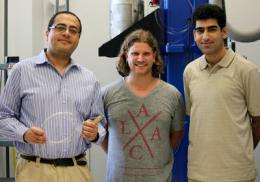New nanoparticle discovery opens door for pharmaceuticals

What a University of Central Florida student thought was a failed experiment has led to a serendipitous discovery hailed by some scientists as a potential game changer for the mass production of nanoparticles.
Soroush Shabahang, a graduate student in CREOL (The College of Optics & Photonics), made the finding that could ultimately change the way pharmaceuticals are produced and delivered.
The discovery was based on using heat to break up long, thin fibers into tiny, proportionally sized seeds, which have the capability to hold multiple types of materials locked in place. The work, published in the July 18 issue of Nature, opens the door to a world of applications.
Craig Arnold, associate professor of Mechanical and Aerospace Engineering at Princeton University and an expert in laser material interactions who did not work on the project, said no one else in the field has been able to accomplish that feat.
With a new non-chemical method of creating identical particles of any size in large quantities, "the possible applications are up to your imagination," Arnold said.
The most immediate prospect is the creation of particles capable of drug delivery that could, for example, combine different agents for fighting a tumor. Or it could combine a time-release component with medications that will only activate once they reach their target – infected cells.
"With this approach you can make a very sophisticated structure with no more effort than creating the simplest of structures," said Ayman Abouraddy, an assistant professor at CREOL and Shabahang's mentor and advisor. Abouraddy has spent his career, first at the Massachusetts Institute of Technology and now at UCF, studying the fabrication of multimaterial fibers.
The technique relies on heat to break molten fibers into spherical droplets. Imagine water dripping from a faucet. Glass fibers are perhaps best known as the cylindrical cables that transmit digital information over long distances. For year, scientists have been looking for ways to improve the purity of glass fibers to allow for faster, disruption-free transmission of light waves.
Shabahang and fellow graduate student Joshua Kaufman were working on just such a project, heating and stretching glass fiber on a homemade tapering machine. Shabahang noticed that instead of the desired result of making the center of the cable thinner, the material actually broke apart into multiple miniature spheres.
"It was kind of a failure to me," Shabahang said.
However, when Abouraddy heard what had happened he knew right away that this "mistake" was a major breakthrough.
While at MIT, Abouraddy and his mentor, Yoel Fink, a professor of materials science and current director of MIT's Research Laboratory of Electronics, said they were told by a theoretician that molten optical fiber should align with a process known as Rayleigh instability, which explains what causes a falling stream of fluid to break into droplets.
At the time, the MIT group was focused on producing fibers containing multiple materials. The team produced fibers by heating a scale model called a "preform" and stretching it apart much the way taffy is made. The process is known as thermal drawing.
Shabahang's experiment shows that by heating and then cooling multimaterial fibers, the theoretical became reality. Uniform particles that look like droplets are produced. Moreover, Shabahang demonstrated that once the spheres form, additional materials can be added and locked into place like LEGO building blocks, resulting in particles with sophisticated internal structures.
Especially significant is the creation of "beach ball" particles consisting of two different materials melded together in alternating fashion, similar to the stripes on a beach ball.
Kaufman, Shabahang and Abouraddy contributed to the Nature article in addition to Guangming Tao from CREOL, UCF; Esmaeil-Hooman Banaei from the Department of Electrical Engineering & Computer Science, UCF; Daosheng S. Deng, Department of Chemical Engineering, MIT; Xiangdong Liang, Department of Mathematics, MIT; Steven G. Johnson, Department of Mathematics, MIT; and Yoel Fink from MIT.
More information: www.nature.com/nature/journal/ … ull/nature11215.html
Journal information: Nature
Provided by University of Central Florida




















